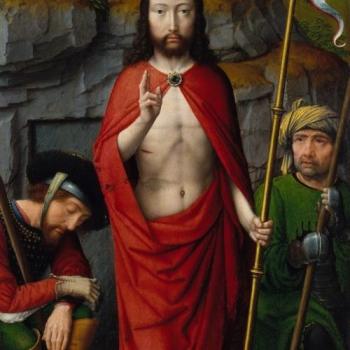Upon what evidence was the blind man relying when he addressed him as “son of David”?
We don’t know, but presumably it was the same evidence that motivated huge crowds to follow Jesus, in short, his preaching and his signs–-all the stuff the New Testament describes him saying and doing. Bartimaeus, like Peter, came to the conclusion that it all pointed to the conclusion that he was the Christ(=”son of David”=”Messiah”).
By the way, note how completely Judeocentric the entire conversation is. Despite the endless assertions in contemporary culture about how the story of Jesus is just a warmed-over pagan myth (on the basis of a few weak tea similarities between Jesus and a couple of themes in pagan mythology that you could equally use to say he is a “warmed-over DC comic”) what is blazingly obvious from the NT is that nobody is thinking about paganism, except in passing. Everybody is hyper-focused on Jesus as the fulfillment of the Old Covenant and of the promises to the House of David of a Messiah. Later on, when the Church begins its mission, it will occasionally note dim resemblances between Jesus and some aspects of pagan culture (as, for instance, Paul does on the Areopagus in Acts 17). But quite obviously, what the apostles are interested in is how Jesus fulfils the Jewish prophecies and the Jewish cultic practices because they devoutly believe that God really has made a covenant with the Jews (several covenants actually, with Abraham, Moses, and David) that he did not make with the Gentiles and that therefore “salvation is of the Jews”. To be sure, the Chosen are chosen for the sake of the unchosen. But Chosen they are. And Jesus is, for the New Testament writers, the Chosen of the Chosen: it was for the sake of his coming that Israel was chosen out of all the nations of the earth.
Bottom line: if you want to understand the New Testament, don’t waste time looking for sketchy and highly dubious parallels with Osiris or Diana or Mithras. Look at the obvious: look at the Old Testament. The NT writers have one eye on Jesus and the other on the revelation to the Jews. They frankly don’t much care about pagan religons beyond that, regarding them as either merely human, or dim perceptions of a few truths that even the Gentile can figure out, or as demonic deceptions (all three strains of thought are present in both the Old and New Testaments). But they simply do not waste any time looking to paganism as a source of their tradition and, in fact, repeatedly warn against doing so (that’s what all that stuff about not trust human traditions and mythologies–both Jewish and Gentile–is about in Paul).
That’s because, when they met the risen Christ on the Emmaus road, he didn’t preach to them about the Messiah who affirms the universal equality of all religions as equal paths to God. He spoke as a Jew who said that the entirety of Moses and the Prophets (not the Egyptian Book of the Dead, the Bhagavad Gita, or the Iliad) was really about him, inspired by the Holy Spirit, and intended to give them insights into his mission and the mission of the Church. The apostles and the Church after them simply follow suit and therefore walk the tightrope of subordinating the message of the Old Testament to Jesus, yet never following heretics like Marcion and chucking the Old Testament, nor listening to gnostics who tried to import alien ideas from paganism into the gospel.
The early Christians, starting with the apostles, believe Jesus that he comes to fulfil, not abolish, the Law and the Prophets. They will occasionally press into service some image from paganism to illustrate their message (i.e. the Monument to the Unknown God or, later, things like wedding rings, Christmas trees, or Easter eggs). But note that the pagan image is always filled with Christian content. The Christian or Jewish image is never filled with pagan content.











